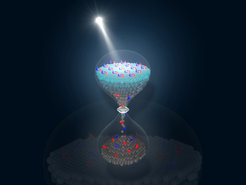Long live superconductivity! Short flashes of light with sustaining impact

Superconductivity is one of the most fascinating and mysterious phenomena of modern physics. It describes the sudden loss of electrical resistance in certain materials when they are cooled below a critical temperature. However, the need for such cooling still limits the technological usability of these materials.
In recent years, research by Andrea Cavalleri’s group at the MPSD has revealed that intense pulses of infrared light are a viable tool to induce superconducting properties in a variety of different materials at much higher temperatures than would be possible without photo-stimulation. However, these exotic states have so far persisted for only a few picoseconds (trillionths of a second), thus limiting the experimental methods for studying them to ultrafast optics.
A pathbreaking advance has been reported this week. Researchers in the Cavalleri group have now managed to increase the lifetime of such a light-induced superconducting state by more than four orders of magnitude in the organic superconductor K3C60, which is based on fullerenes (‘soccer ball’ molecules formed by 60 carbon atoms). “We have discovered a long-lived state with vanishing resistance at a temperature five times higher than the one at which superconductivity sets in without photoexcitation,” says lead author Matthias Budden, a doctoral student at the time of the research.
“The key ingredient for this success was our development of a new type of laser source that can produce high-intensity, mid-infrared light pulses with tunable duration from about one picosecond to one nanosecond,” adds co-author Thomas Gebert. The new laser type is based on the synchronization of high-power gas lasers with relatively long nanosecond pulses to the ultra-precise rhythm of much shorter solid-state laser pulses.
When such long and intense pulses of infrared light hit a material, they can induce molecular vibrations, lattice distortions and even changes in the electronic configuration. Given the complexity of these processes, it is not surprising that several vastly different theories have been proposed to describe the physics of light-enhanced superconductivity. Surprisingly, the authors discovered in their new work that superconductivity persisted for tens of nanoseconds after photo-excitation. These significantly prolonged lifetimes of the superconducting states enabled the team to systematically study the materials’ electrical resistance. Although a microscopic description of light-induced superconductivity in K3C60 is still missing, these results represent a new benchmark for current theories.
“Most importantly,” Matthias Budden concludes, “our work paves the way for pressing experiments on a photo-induced Meissner effect and inspires thoughts about applications of superconducting circuits in integrated devices based on state-of-the-art high-speed electronics.” Such applications include extremely sensitive magnetic field sensors, high-performance quantum computing and lossless power transmission. More generally, thanks to the novel approach of combining longer mid-infrared excitation pulses with direct measurements of electronic and magnetic properties, the MPSD team aims to improve the control and understanding of the many fascinating phenomena in complex materials.
This research received funding from the European Research Council (ERC) Synergy Grant “Frontiers in Quantum Materials’ Control” (Q-MAC) and from the Deutsche Forschungsgemeinschaft (DFG) via the Cluster of Excellence ‘The Hamburg Centre for Ultra-fast Imaging’. The experiments were performed in the laboratories of the Center for Free-Electron Laser Science (CFEL), a joint enterprise of DESY, the Max Planck Society, and the University of Hamburg. The research was carried out in close collaboration with scientists of the University of Oxford (UK), the University of Parma (IT) and of the ELETTRA Synchrotron Facility, Trieste (IT).












